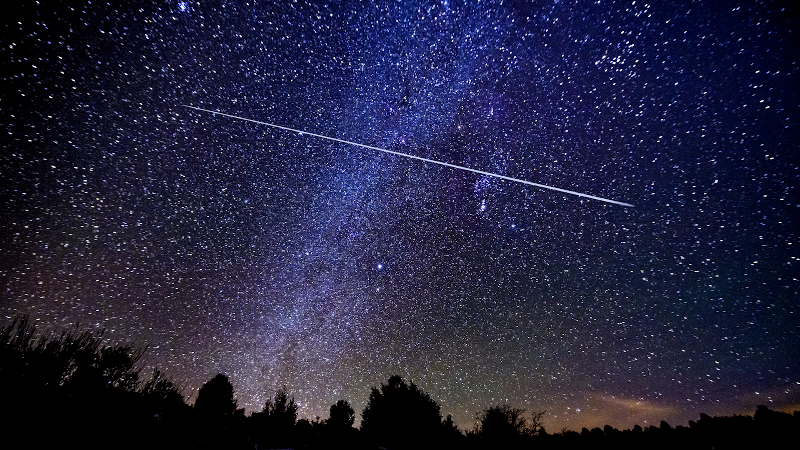When is the Lyrid meteor shower? See peak days, cloud forecast when fireballs are active
It's possible storms and clouds could spoil views in parts of the U.S. of the Lyrid meteor shower when it peaks April 21 and April 22.

Shooting stars are about to streak across the night sky during the impending peak of the second major meteor shower of the year, which will be visible around the world.
But this year, it's possible inclement weather could spoil views in parts of the U.S. of the Lyrid meteor shower, which is due to become most active between Monday, April 21 and Tuesday, April 22.
Formed from leftover particles from comet Thatcher, the Lyrids are the oldest known meteor shower – having been observed for thousands of years. The meteor shower becomes visible to us here on Earth like clockwork every April as our planet passes through the debris trail and bright whizzing fireballs appear in our night sky.
This year, though, storms and clouds are in the forecast that could obscure the view in the northern and eastern United States. Fortunately for stargazers further west and south, clear skies should still provide ideal viewing conditions.
Here's what to know about the Lyrid meteor shower and how to see it this year:
When is the Lyrid meteor shower peaking?
The Lyrid meteor shower, which first became active Thursday, is the second meteor shower of 2025 after the Quadrantids peaked in January.
The meteors will hit their peak in activity between Monday, April 21 and Tuesday, April 22 before beginning to slow down and stop altogether by April 26, according to the American Meteor Society. The timing means the Lyrids activity will overlap with another meteor shower known as the Eta Aquariids, which won't hit its peak until May 5 and 6.
What time can I see the Lyrids?
The Lyrids are best viewed in the Northern Hemisphere during the dark hours between midnight and dawn.
The website Time and Date also provides detailed information about where and when to see the phenomenon.
How to see the Lyrids
The meteors seem to emerge – or radiate – from the constellation Lyra, specifically a bright star named Vega, according to astronomers.
Seasoned stargazers should easily be able to find Vega in the night sky, but if you need help locating it, look above the horizon toward the northeast between about 9 to 10 p.m. ET. Vega will then continue to climb upward until it is high enough in the sky that meteors radiating from that direction streak across, according to Earth Sky.
But while the radiant appears to be the "source" of the meteors, looking away from it will in fact make the meteors "appear longer and more spectacular," according to NASA. Getting away from city light pollution and street lights will also help to unveil the best sights.
Will it be cloudy during the Lyrid meteors peak?
Cloud and storms may interfere with the view of the Lyrid meteor shower for some observers this year, according to AccuWeather.
The commercial weather forecasting service says a storm is expected to move across the eastern half of North America during the peak shower activity, spreading clouds across most of the East Coast. Another storm is expected to bring cloudy conditions across much of the north-central U.S., AccuWeather said.
That makes the West Coast and Southwest U.S., including central Texas, the best place to witness the Lyrids this year. A pocket of the Midwest, including areas west and south of Chicago, should also have good views, according to AccuWeather.
The National Weather Service shared graphics showing the cloud forecast across the U.S. overnight for both Monday and Tuesday.
How many Lyrid meteors will we see per hour?
While NASA notes that the Lyrids can surprise watchers with as many as 100 meteors seen per hour, in general, 10-20 Lyrid meteors can be seen per hour during the peak.
Lyrids don’t tend to leave long, glowing dust trains behind them as they streak through the Earth's atmosphere, but they can produce the occasional bright flash called a fireball.
What causes the Lyrid meteors?
Meteor showers occur when Earth passes through dusty debris trails left by comets and other space objects as they orbit the sun. The debris – space rocks known as meteoroids – collides with Earth's atmosphere at high speed and disintegrates, creating fiery and colorful streaks in the sky, according to NASA.
Those resulting fireballs, better known as "shooting stars," are meteors. If meteoroids survive their trip to Earth without burning up in the atmosphere, they are called meteorites, NASA says.
The Lyrid meteor shower is composed of pieces of debris from the Comet C/1861 G1 Thatcher on its orbit around the sun, which is thought to take nearly 416 years. The comet is named for A. E. Thatcher, who discovered it in 1861.
The meteor shower itself, though, has been observed for 2,700 years ever since the first recorded sighting was made in 687 BC by the Chinese, according to NASA.
Eric Lagatta covers breaking and trending news for Paste BN. Reach him at elagatta@gannett.com